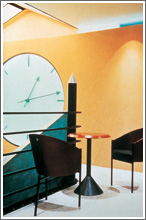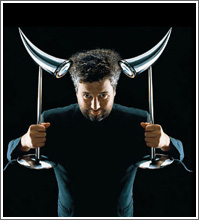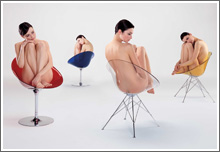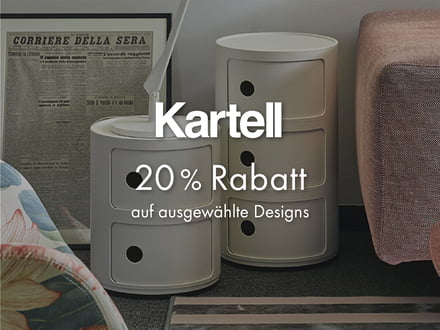
"I am a popular designer, people's homes are my museum.
There you can find my toothbrushes, my chairs, why would I show them in a museum?" Philippe Starck is one of the most famous designers of our time.
There's probably no place where you can't run into one of his objects. In addition to his countless products, Philippe Starck as a person often comes to public attention. The star designer's democratic designs are also as provocative, socially critical and self-critical as his statements and messages.
The Pop Star amongst Designers
Soon after his studies at the end of the 60s he caused attention with a series of blow-up objects. He then worked for two years as art director for fashion designer Pierre Cardin and also gained experience on his first interior design projects for bars, discos and nightclubs.
At the end of the 70s Starck created his first furniture designs, such as the Mac Gee shelf (1979), which is still produced by Italian company Cerruti Italia today. Philippe Starck gained a highly prominent name for himself at the start of the 80s when he took over the interior design of the Elysée Palace in Paris for French president Mitterrand. In 1984 he worked on the interior design of the prestigious Café Costes in Paris, creating the famous three-legged Costes café chair, today produced by Driade.
 Other name-brand manufacturers soon expanded their ranges with original designs by Philippe Starck: toothbrushes, pasta and motorcycles - Starck designed a number of products for various areas of life.At the end of the 80s and start of the 90s, Starck created veritable design icons, including the Juicy Salif lemon squeezer and the "Joe Cactus" ashtray (both 1990) for Alessi, the Ará table lamp for Flos (1988) and the Lord Yo chair for Driade (1994).Ever the eccentric, Starck became the "pop star amongst designers".Not in the least because of the way he drew attention to himself as well as his products.However anyone accusing Philippe Starck of lacking reflection in his work does him an injustice.Starck grappled with the social and moral importance of design in a humorous and theatrical way like no other designer.
Other name-brand manufacturers soon expanded their ranges with original designs by Philippe Starck: toothbrushes, pasta and motorcycles - Starck designed a number of products for various areas of life.At the end of the 80s and start of the 90s, Starck created veritable design icons, including the Juicy Salif lemon squeezer and the "Joe Cactus" ashtray (both 1990) for Alessi, the Ará table lamp for Flos (1988) and the Lord Yo chair for Driade (1994).Ever the eccentric, Starck became the "pop star amongst designers".Not in the least because of the way he drew attention to himself as well as his products.However anyone accusing Philippe Starck of lacking reflection in his work does him an injustice.Starck grappled with the social and moral importance of design in a humorous and theatrical way like no other designer.
 The variety of his objects can be evaluated in terms of their idealistic and emotional values as well as with consideration of economic aspects.The catalogues for "Good Goods" or manifesto for "Democratic Design", both created by him, pursued the goals of increasing the quality of products, reducing their price and changing the way they were sold so that design became accessible for all.An objective which the Bauhaus strove for and which Starck today sees as mostly achieved.Intangible parameters such as sex, sensuality and symbolism play an equally important role in Starck's design as the price and production conditions of his designs - he was happy to name his plastic chair Louis Ghost, which he designed for Kartell in 2002, "a kind of post-Freudian Bauhaus chair".
The variety of his objects can be evaluated in terms of their idealistic and emotional values as well as with consideration of economic aspects.The catalogues for "Good Goods" or manifesto for "Democratic Design", both created by him, pursued the goals of increasing the quality of products, reducing their price and changing the way they were sold so that design became accessible for all.An objective which the Bauhaus strove for and which Starck today sees as mostly achieved.Intangible parameters such as sex, sensuality and symbolism play an equally important role in Starck's design as the price and production conditions of his designs - he was happy to name his plastic chair Louis Ghost, which he designed for Kartell in 2002, "a kind of post-Freudian Bauhaus chair". Philippe Starck is indeed considered an "enfant terrible" on the design scene, though the number of awards and prizes, the presence of his objects in the collections of major international museums and not least the enormous sales figures for his products make Starck one of the most important designers of the contemporary era.Today, Starck focusses on honest and lasting design that achieves lots and most of all with little effort."My staff and I try to take away more and more material with every object.Until the computer says: up to here and no further, otherwise the product falls apart.Packaging that only looks pretty, we don't do that."Despite several flirtations with ending his career, Starck hasn't given up on his work yet.On the contrary, he is currently planning the interior of a Virgin Galactic space ship which will soon be used to carry tourists into space.
Philippe Starck is indeed considered an "enfant terrible" on the design scene, though the number of awards and prizes, the presence of his objects in the collections of major international museums and not least the enormous sales figures for his products make Starck one of the most important designers of the contemporary era.Today, Starck focusses on honest and lasting design that achieves lots and most of all with little effort."My staff and I try to take away more and more material with every object.Until the computer says: up to here and no further, otherwise the product falls apart.Packaging that only looks pretty, we don't do that."Despite several flirtations with ending his career, Starck hasn't given up on his work yet.On the contrary, he is currently planning the interior of a Virgin Galactic space ship which will soon be used to carry tourists into space.
Website by Philippe Starck
 Alessi
Alessi
 Baleri Italia
Baleri Italia
 Driade
Driade
 Flos
Flos
 Kartell
Kartell